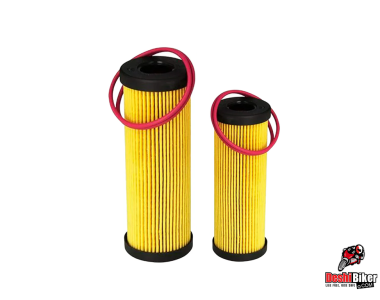What is a Leading Link Suspension or Fork in a Motorcycle? See Leading Link Suspension’s mechanism with benefits, drawbacks, differences with other types of suspensions, and more. You may also find a comparison between Leading link suspension vs telescopic vs Trailing Link suspension.
What is Leading Link Suspension?
Leading link suspension comes with a wheel being suspended ahead of the pivot point through a link. Why is it called a leading link suspension? As the link leads to the pivot point, this type of suspension got such a name. Basically, it’s the opposite of the trailing link suspension. Some people also recognize it as leading arm suspension. Able to absorb small bumps and imperfections.
Advantages of Leading Link Forks
Its major benefits include natural anti-dive tendency as well as little change in wheelbase between unloaded and fully loaded conditions. As it is attached to the frame of the motorcycle, doesn’t tend to develop leaks.
Great Response Encountering Bumps: The brakes act against the compression of the suspension. Thus this type of fork doesn’t let the bike to the bottom and provides great response while encountering bumps.
Stability: Offers improved stability at higher speeds. Compared to the traditional telescopic forks, it will be well ahead. Better stability is ensured as it maintains a consistent wheelbase during cornering.
Sheer Comfort: Even over rough terrain, the users enjoy comfortable rides. It’s because of the suspension’s better shock and bump-absorbing ability. Off-road use or touring cases; comfort is guaranteed in every case.
Better Ground Clearance: Its enhanced Ground Clearance also makes it suitable for off-road usage.
Adjustability: Provides easier adjustments to preload and damping. Thus, a user can adjust it according to his preference or the bike’s load condition.
Decreased Brake Dive: It minimizes brake dives. It’s actually the tendency of the front end to compress under braking.
Disadvantages of Leading Link Suspension
Over-weight: This type of suspension is heavier than its other counterparts. Thus it increases the overall weight of the motorcycle.
Higher Cost: The cost is higher than that of standard forks in both manufacturing and maintenance. Thus users need to purchase it at a higher cost and also the maintenance may cost them more.
Complexity: Comes with a complex mechanical design. It may result in additional maintenance requirements and also potential points of failure.
Limited Availability: The alluded types of forks are not widely used. Thus one may suffer while searching for replacement parts. Aftermarket modification might also be tough, given the limited options available.
Different Steerling Feel: With varied feeling being at the steering many riders won’t feel comfortable while riding.
Unattractive Look: A leading link doesn’t provide a great look of the bike. So, many users may not like the appearance of the bike featuring leading link forks.
What is the Difference between Leading Link and Trailing Link?
The leading link forks and trailing forks are opposite to each other. They have some key differences. Those are:
| Leading Link Suspension | Trailing Link Suspension |
| It has the axle ahead of the pivot point. | It puts the axle behind the pivot point. |
| The wheel is suspended ahead of the pivot point through a link. | Features one or more arms, or links, connected between the axle and pivot point. |
| Also called a leading arm suspension. | Also known as a trailing arm suspension. |
Is Leading Link Suspension Good?
If you prefer stability and comfort over long distances then it will be a top choice. Leading link forks are able to serve better on rough terrain. But considering the higher cost and complex manufacturing along with its excessive weight may discourage some users from having this sort of suspension. So, it depends on the rider’s choice and riding style.


























